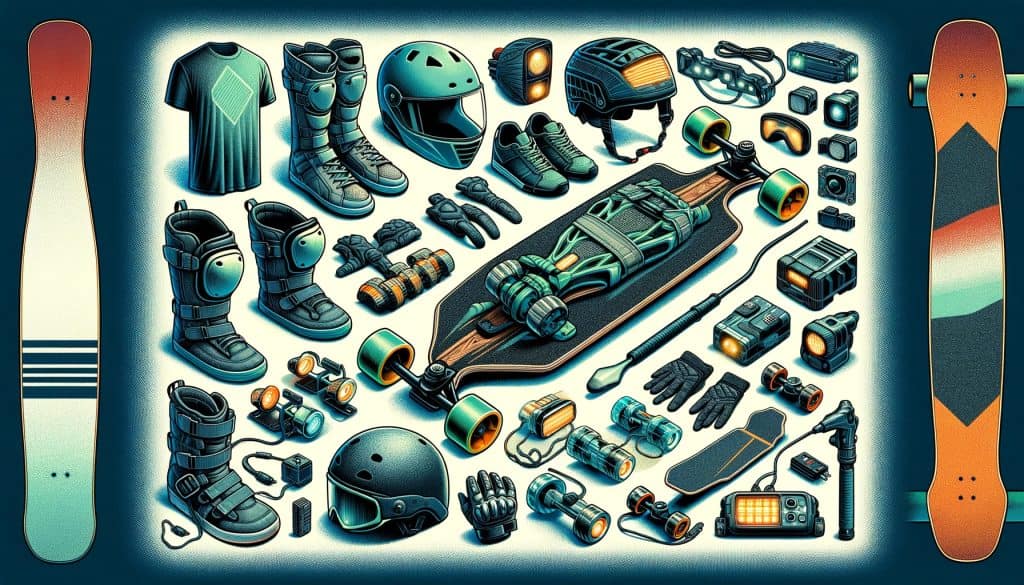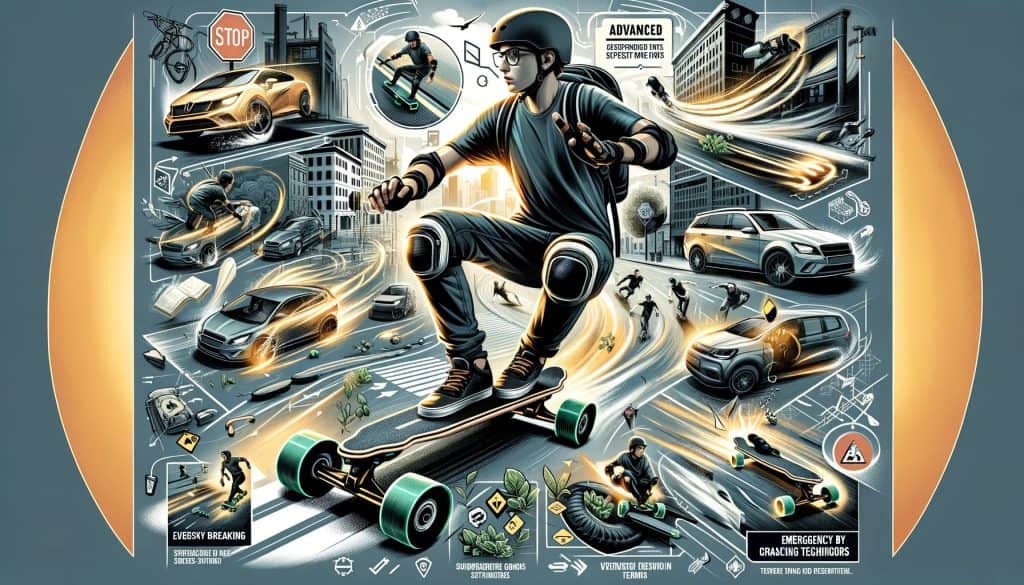Electric longboards are rapidly becoming a staple in urban mobility, offering a unique blend of convenience, speed, and eco-friendliness. This trend isn’t just a fleeting fad; it’s an evolution in how we think about personal transport in our increasingly congested cities.
Gone are the days when longboards were seen merely as a tool for recreation.
Today, they are a symbol of modern urban mobility, embraced by a diverse range of individuals for their efficiency and fun factor.
The appeal of electric longboards lies in their ability to make transportation not just practical but enjoyable. They offer a fresh, exhilarating way to navigate t ough city streets, parks, and campuses.
Unlike traditional modes of transport, electric longboards provide a sense of freedom and autonomy, allowing riders to avoid traffic jams and crowded public transport. They’re a perfect fit for the fast-paced, environmentally conscious urban dweller.
However, with this rise in popularity comes a significant responsibility: safety.
As electric longboards become more common, the importance of safe riding practices can’t be overstated. Safety isn’t just about protecting oneself; it’s about respecting fellow pedestrians, motorists, and the urban environment as a whole.
Proper gear, like helmets and protective pads, and adherence to safety norms are essential to ensuring that the joy of riding an electric longboard doesn’t turn into a risk for riders and those around them.
In essence, electric longboards are more than just a cool gadget or a fun way to get around. They’re part of a broader shift towards sustainable, efficient, and enjoyable urban transport. But as we embrace this shift, we must also embrace the responsibility that comes with it.
Safety, in this context, isn’t an afterthought; it’s a prerequisite to ensuring that the integration of electric longboards into our daily lives is beneficial and lasting.
< class="wp-block-separator has-alpha-channel-opacity"/>Understanding the Basics of Electric Longboard Safety
Understanding the basics of electric longboard safety is crucial, not just for personal well-being but also for the well-being of those around you. Electric longboards, while an exciting and efficient mode of transport, come with their own set of risks and challenges. Recognizing and preparing for these risks is key to ensuring a safe and enjoyable experience.

Why Safety is Crucial for Electric Longboard Riders:
- High Speeds:
- Electric longboards can reach significant speeds, making falls or collisions potentially more dangerous.
- Balance and Control:
- Maintaining balance, especially for beginners, can be challenging and may lead to falls or loss of control.
- Interactions with Traffic:
- Navigating t ough city traffic requires alertness and adherence to traffic rules to avoid accidents.
- Variable Terrain:
- Different surfaces (smooth, rough, inclined) present unique challenges and can affect the board’s stability.
- Mechanical Failures:
- Malfunctions like battery issues or brake failures can be hazardous if not checked regularly.
- Distractions:
- External factors like phone usage or headphones can distract riders, increasing the risk of accidents.
Common Risks Associated with Electric Longboarding:
- Injuries from Falls:
- This includes scrapes, bruises, broken bones, or more severe injuries.
- Collisions with Vehicles or Pedestrians:
- Especially in urban areas, the risk of collision can be high.
- Equipment Malfunction:
- Issues with the board itself can lead to accidents.
- Environmental Hazards:
- Potholes, wet surfaces, and unexpected obstacles can cause falls.
- Lack of Visibility:
- Riding at night or in low-light conditions without proper lighting can lead to accidents.
- Inadequate Skill Level:
- Overestimating one’s ability to control and maneuver the board can lead to risky situations.
Understanding these risks and preparing accordingly is the first step towards a safe longboarding experience.
The right safety gear, regular maintenance of the longboard, adherence to traffic rules, and a good understanding of one’s own abilities can significantly reduce these risks. Safety, in this context, is not just a set of guidelines but a mindset that every rider should adopt.
< class="wp-block-separator has-alpha-channel-opacity"/>Essential Safety Gear

When it comes to electric longboarding, having the right safety gear is not just a recommendation, it’s a necessity. The exhilaration of gliding t ough the streets can quickly turn perilous without proper protection. Let’s break down the essential safety gear and why each piece is crucial.
1. Helmets:
- Types Suitable for Electric Longboarding:
- Full-face helmets: Offer complete protection, ideal for high-speed or downhill riding.
- Multi-sport helmets: Versatile and suitable for various types of riding.
- Skate-style helmets: Popular for their comfort and style, providing good coverage.
- Choosing the Right Fit and Safety Standards:
- Size and Fit: Ensure the helmet fits snugly; it shouldn’t wobble or pinch.
- Safety Certifications: Look for certifications like CPSC, ASTM, or EN1078, indicating the helmet has passed safety tests.
- Comfort and Ventilation: Comfort is key for longer rides. Ensure the helmet has good ventilation.
2. Protective Pads and Gloves:
- Knee and Elbow Pads:
- Absorb impact and protect against scrapes and cuts.
- Look for pads with a comfortable fit and sturdy straps.
- Consider pads with hard shells for extra protection.
- Gloves:
- Protect hands in case of a fall and improve grip.
- For beginners, gloves can also provide confidence.
- Options include fingerless for agility or full-fingered for complete protection.
3. Lights and Reflective Gear:
- Importance in Low-Light Conditions:
- Lights increase visibility to others, especially important in urban areas.
- Reflective gear makes you visible from a distance in low light.
- Recommendations:
- Front and rear lights: Essential for being seen and seeing the path ahead.
- Reflective vests or strips: Can be worn over regular clothes.
- Helmet with integrated lights: Adds an extra layer of visibility.
Incorporating these safety items into your longboarding routine can significantly reduce the risk of injury and make your ride safer and more enjoyable. Remember, the best rides are the ones where you come home safe.
< class="wp-block-separator has-alpha-channel-opacity"/>Electric Longboard Maintenance for Safety

Maintaining your electric longboard isn’t just about prolonging its lifespan; it’s a crucial aspect of riding safety. Regular inspections and maintenance ensure that your longboard is always in top condition, reducing the risk of accidents due to equipment failure. Let’s look at a simple yet effective maintenance checklist and understand why each step is important.
Regular Inspection Checklist:
- Wheels:
- Check for any signs of wear or damage.
- Ensure the wheels spin freely and bearings are clean.
- Tighten any loose nuts and replace worn-out wheels.
- Deck:
- Inspect the deck for cracks, splits, or warping.
- Clean the deck to prevent buildup of dirt and grime.
- Check the grip tape for wear and replace it if necessary.
- Battery:
- Regularly check the battery charge and health.
- Ensure all connections are secure and clean.
- Store the battery properly, avoiding extreme temperatures.
- Trucks and Bushings:
- Ensure trucks are properly aligned and not too tight or loose.
- Inspect bushings for wear and replace if they are cracked or deformed.
- Electronics and Motor:
- Keep the electronics clean and dry.
- Check for loose connections or wires.
- Listen for any unusual sounds from the motor, which might indicate a problem.
- Braking System:
- Test the brakes regularly to ensure they are responsive.
- Look for any signs of wear or damage in mechanical parts.
Importance of Keeping the Longboard in Top Condition:
- Safety: Regular maintenance prevents malfunctions that could lead to accidents.
- Performance: A well-maintained board will perform better, giving a smoother and more efficient ride.
- Longevity: Proper care extends the lifespan of your longboard, saving you money in the long run.
- Confidence: Knowing your board is in good condition gives you confidence and peace of mind while riding.
Incorporating these maintenance routines into your longboarding practice can greatly enhance your overall experience. It’s not just about fixing things when they break; it’s about proactive care to ensure your rides are safe, smooth, and enjoyable.
< class="wp-block-separator has-alpha-channel-opacity"/>Riding Practices for Safety

Riding an electric longboard safely is a skill that evolves over time. It begins with mastering the basics and gradually progresses to more complex scenarios like navigating traffic or varied terrains. Here’s a guide to help you develop these skills methodically and safely.
Starting Off: Learning the Basics
- Start in a Safe, Open Area:
- Practice in a flat, open space like an empty parking lot or a quiet street.
- Get familiar with the feel of the board under your feet and its response to your movements.
- Understanding Your Longboard:
- Learn how to turn on and off your longboard.
- Get comfortable with the acceleration and braking mechanism.
- Basic Maneuvers:
- Practice simple moves like starting, stopping, turning, and braking.
- Gradually increase speed as you gain confidence.
Mastering Control and Balance
- Balance Exercises:
- Practice standing on the longboard while it’s stationary to improve your balance.
- Try shifting your weight from side to side and front to back.
- Moving Practice:
- Begin with slow speeds and gradually increase as you get more comfortable.
- Focus on smooth starts and stops.
- Turning Techniques:
- Practice wide and tight turns to understand how your longboard responds.
- Learn to adjust your body weight to steer the board.
Navigating T ough Traffic
- Awareness:
- Be aware of your surroundings, including pedestrians, vehicles, and obstacles.
- Always follow traffic rules and use hand signals to indicate turns.
- Defensive Riding:
- Assume that others may not see you and ride accordingly.
- Keep a safe distance from other vehicles and avoid riding in blind spots.
- Emergency Maneuvers:
- Practice quick stops and evasive maneuvers to use in unexpected situations.
Dealing with Different Terrains
- Smooth Surfaces:
- Ideal for beginners. Focus on honing your skills on flat, smooth surfaces.
- Rough Surfaces:
- Be cautious of obstacles like rocks and cracks.
- Learn to adjust your speed and balance to navigate safely.
- Inclines:
- Practice going up and down hills at a controlled speed.
- Understand how gravity affects your control and speed.
By following these steps and practicing regularly, you’ll develop the skills and confidence needed to enjoy electric longboarding safely. Remember, the key to safe riding is not just about handling the longboard well, but also being aware of and adapting to your environment.
< class="wp-block-separator has-alpha-channel-opacity"/>Advanced Safety Tips

As you grow more comfortable and skilled in electric longboarding, it’s important to advance your safety knowledge too. This means learning strategies to avoid common hazards and mastering emergency maneuvers and braking techniques. Here are some advanced tips to help you stay safe on your rides:
Strategies for Avoiding Common Hazards:
- Anticipate and Plan:
- Always look ahead and anticipate potential hazards like potholes, wet surfaces, or sudden changes in terrain.
- Plan your route to avoid high-traffic areas or poorly maintained roads.
- Ride at Safe Speeds:
- Keep your speed at a level where you can react and stop safely if needed.
- Be Visible:
- Wear bright clothing during the day.
- Use lights and reflective gear in low-light conditions.
- Stay Alert:
- Avoid distractions like using a phone or listening to loud music.
- Stay focused on the environment and potential hazards around you.
Emergency Maneuvers and Braking Techniques:
- Quick Stops:
- Practice stopping quickly and safely from various speeds.
- Learn to shift your weight to the rear of the board to enhance braking efficiency.
- Evasive Maneuvers:
- Master quick turns or jumps to avoid sudden obstacles.
- Practice swerving around objects at safe speeds to improve your reaction time.
- Handling Slips and Skids:
- Learn to control and correct the board if it begins to slip or skid.
- Stay calm and steer in the direction of the skid while gradually slowing down.
- Falling Safely:
- If a fall is inevitable, try to roll onto your shoulder to minimize injury.
- Practice tucking and rolling in a safe environment to prepare for such situations.
By mastering these advanced safety tips, you’ll not only enhance your riding experience but also significantly reduce the risk of accidents. Remember, proficiency in these skills comes with practice and experience. Always wear your safety gear, and never stop learning and improving your riding techniques.
< class="wp-block-separator has-alpha-channel-opacity"/>Staying Informed and Updated

In the dynamic world of electric longboarding, staying informed and updated is as crucial as wearing a helmet. It’s not just about keeping up with the latest trends but also about being aware of the changing landscape of safety and regulations.
Importance of Staying Updated with Local Regulations:
- Compliance with the Law:
- Laws regarding electric longboarding can vary by city or country. It’s essential to know and comply with these laws to avoid fines or legal issues.
- Riding Responsibly:
- Being aware of local regulations helps in promoting responsible riding practices, which benefits both the rider and the community.
- Advocacy and Community Involvement:
- Understanding regulations allows riders to participate in advocacy efforts for better longboarding laws and infrastructure.
Keeping Abreast of New Safety Gear and Practices:
- Enhancing Safety:
- The world of safety gear is constantly evolving. Staying informed about new gear can significantly enhance your safety on the board.
- Community Learning:
- Engaging with the longboarding community, either online or in person, is a great way to learn about best practices and share experiences.
- Continuous Improvement:
- Safety isn’t static. By keeping up with new practices and technologies, you ensure that your riding style evolves with the latest safety standards.
Conclusion
T oughout this guide, we’ve explored the essentials of electric longboarding safety. From the right gear to proper riding practices, regular maintenance, and the importance of staying informed, each aspect plays a pivotal role in ensuring a safe riding experience.

Electric longboarding is not just a mode of transportation or a recreational activity; it’s a lifestyle choice that combines fun, freedom, and responsibility. By prioritizing safety, you ensure that this enjoyable experience remains a positive and integral part of your daily life.
Remember, the best longboarder is not just the one who rides the fastest or the farthest, but the one who rides the safest. Stay safe, stay informed, and enjoy the ride!


